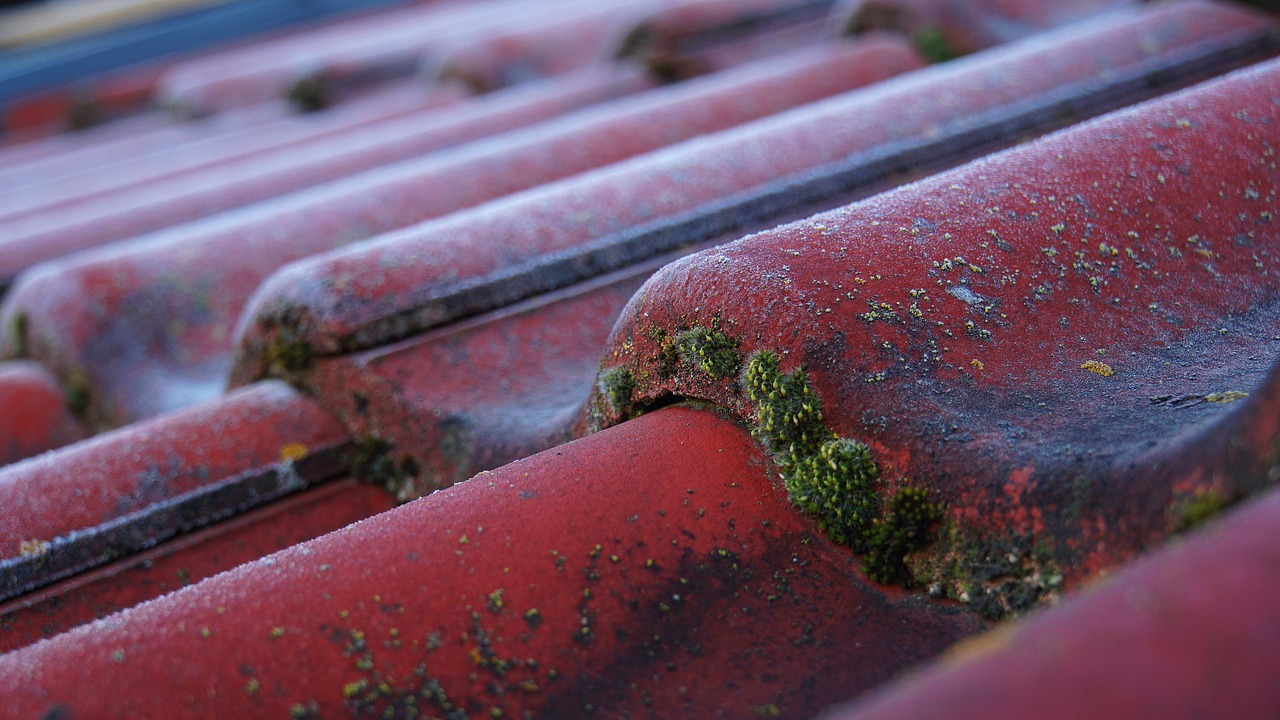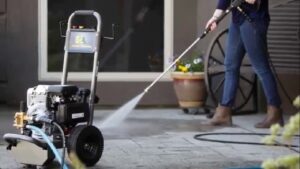The outside of your house is your first opportunity to make a good impression on passersby, guests and neighbors. If you’re planning to sell your house, a clean and well-maintained exterior is all the more important.
Keeping your roof clean is a simple, but effective way to improve the curb appeal at your residence. Black stains on your roof can unsightly, and make an otherwise perfect house seem neglected. But what causes black stains on your roof, and how can you fix them?
What’s the Difference Between Mold, Mildew and Algae?
While many homeowners believe that black roof stains come from mold, mildew or even soot, it’s actually caused by an algae. There are a few important differences between algae, mold and mildew.
The good news is that algae is less harmful than mold and mildew, making it more of an aesthetic problem than a health concern. The bad news is that sometimes homeowners struggle to tell the difference between mold, mildew and algae.
What is Mold and Mildew?
Mold and mildew are both fungal growths that can appear in your home. While mold is a broad term which includes a wide variety of different types of fungal growths, mildew is a particular kind of mold which grows mainly on organic materials.
Mold can be very dangerous for your health, especially black mold (also known as stachybotrys chartarum) which often grows in different areas inside the home. Other common household molds include penicillium, aspergillus, alternaria. Many different mold types can appear black, so it’s often difficult to tell the difference between stachybotrys chartarum and other mold types.
Scientifically speaking, mildew grows only on plants – especially certain varieties of plants predisposed to mildew problems. However, when it comes to your house, any flat-growing mold growth can be referred to as mildew. Mildew can also growing indoors can have negative consequences for your health – coughing, headaches and allergies are common symptoms. It’s generally not as dangerous as black mold, but it can be hard to tell the difference.
Common household molds penetrate surface of an area where they grow, with spores reaching even beneath the surface. Mildew, on the other hand, only grows on top of surfaces.
Both mold and mildew are a cause for concern, but if you have a growth in your house and you’re uncertain whether it’s black mold, or just black mildew, a simple bleach test can help. Put a few drops of bleach on the area where you see the growth and leave it for a while. If it becomes lighter, it’s likely to be mildew. Growths that stay dark after applying bleach are more likely to be mold.
If you suspect you have mildew, it can easily be cleaned with some cleaning equipment. Just be sure to wear gloves and a face mask while cleaning. Use bleach, a scrubbing brush, sponges or cloths to clean – whatever works best for you. Just be sure to discard of all your cleaning materials when you’re done, as reusing them on other surfaces can spread spores, causing growths to appear in new areas.
If your fungal growths appear to be mold. It’s always best to call a professional cleaning company. Cleaning mold yourself could cause a major health hazard and any improper practices while cleaning could help the mold spread throughout your house more.
If you’ve performed the bleach test and you’re still uncertain if the growth you have is mold or mildew, have it tested to make sure what you’re dealing with.
How is Algae Different?
By understanding a bit more about mold and how it grows, distinguishing between mold and algae will be easier.
Algae usually grows only on the outside of your home. It’s unsightly, but it causes no threat to your health. Whereas mold and mildew can lead to health problems, algae is nothing but a nuisance.
Although algae can grow anywhere, it prefers to grow in warm, humid weather conditions. This makes Miami, FL one of the worst affected areas in America when it comes to mold growth on rooftops.
Unfortunately, there’s no way to get rid of mold growth on your roof permanently. Spores are always present in the air. In time, algae will reappear on your roof, even if you had it cleaned. How soon after cleaning the algae comes back can depend. In weather conditions that are favorable for algae growth, it tends to reappear sooner.
Mold can spread inside your home if it’s currently growing on the outside surfaces, such as your roof, sidings or deck. Check the inside of your home for any growths. Especially areas that are dark or moist – your bathroom, basement or any other area of your home that’s often exposed to moisture are good places to keep an eye on.
If there’s any mold or mildew growing inside your home, a good clean both inside and out might be necessary.
Gloeocapsa Magma: The Stain-Forming Algae
Keeping an eye out for mold and mildew can save you a lot of effort and money. By identifying and controlling mold growth on your home’s exterior, you could prevent mold from spreading inside as well.
However, black stains on your roof most often aren’t a cause for concern. Usually, these unsightly marks are caused by a kind of algae called gloeocapse magma (often called blue green algae).
It’s usually hard to see gloeocapse magma in the early stages of growth. After a while, however, the growth will begin to show as black streaks on the roof. This is because gloeocapse magma forms a outer layer that’s darkly-pigmented. This coating offers protection against UV rays, helping the algae survive on your roof.
Algae growth can be found on any roof, but it’s most common on asphalt shingles. This is because asphalt shingles contain fillers such as limestone and crushed fiberglass. These fillers, especially the limestone, made asphalt shingles much cheaper, but they provide the perfect place for algae to thrive.
If algae is left uncleaned, it can combine with all kinds of different fungi and form lichen on your roof. Because lichen can have roots, it can be harder to clean than only blue green algae, so it’s always best to take care of algae problems as soon as possible.
How to Clean Black Roof Stains?
Cleaning black roof stains can be done in multiple ways to clean a roof. Using bleach is effective, as it kills off algae and other growths present.
Many professional roof cleaners make use of pressure washers to clean roofs. Pressure washing is combined with a special cleaning agent to kill off fungal growth and spores. While this method can be effective, it’s important to ensure that the company you hire has trained professionals. Too much pressure can damage your roof, which will do more harm than good.
If you don’t want a professional roof cleaner to use a pressure washer to clean your roof, ask about cleaning with a pump-type garden sprayer. This method can take much longer and will probably cost quite a bit more, but there’s less risk of damage to your roof.
If you’re up for a challenge and you have free time on your hands, you could also try to clean your roof yourself. However, this isn’t really recommended, as you can easily slip and fall while cleaning.
If you can put some safety measures in place to prevent a fall, you can clean your roof using bleach and water. Mix bleach and water. One part bleach for 5 parts water is a good ratio for dilution. Using a garden sprayer, you can spray your whole rood down with the bleach solution. After leaving it for 15-20 minutes, you can return and spray down the roof with a garden hose fitted with a spray nozzle.
When cleaning your roof, it’s important to wear protective gear. Gloves, slip resistant shoes and protective clothing are all necessary for protection. Once you’ve treated your roof with the bleach solution, it can become very slippery – avoid walking around on your roof as much as possible. Also consider the safety of your garden, as cleaning chemicals like bleach can run down your rooftop into your garden, poisoning your plants.
Why Hire Professional Roof Cleaners for Algae Removal?
Cleaning your roof yourself is very dangerous and the results won’t be as good as if you hire a professional. If you clean your roof thoroughly on a regular basis, you can prolong its lifetime and avoid the need to replace shingles.
Even though it seems simple, there are many things to take into consideration when cleaning a roof. Practices to reduce the risk of falls, minimize health hazards and protect the integrity of shingles all combine to provide a clean, perfect result. Another important area of consideration is preventing the cleaning solution from running into your garden, where it can cause damage to grass and plants.
For the well-being of your roof, it’s always best to hire professional roof cleaners for your Miami, FL roof. Hiring professionals not only ensures the best results, it also protects you from the potential hazard of falling. Call Kleanway Pressure cleaning today to schedule a cleaning for your roof. By regularly cleaning your roof and home exterior, you’ll not only have the cleanest house in the street, you’ll also control algae and prevent lichens from forming.





